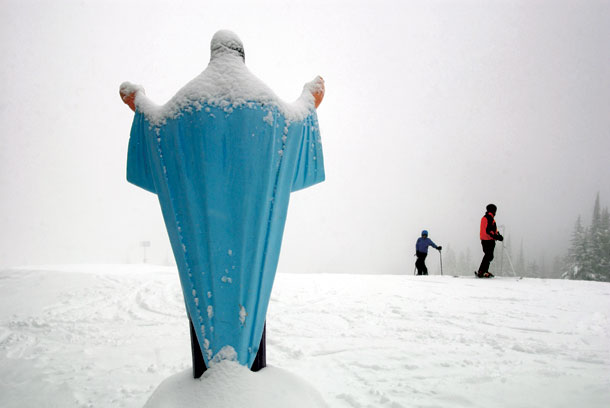WHITEFISH – Dan Graves came across the Jesus Christ statue on Big Mountain for the first time the same way everyone else does: unexpectedly. Graves, the president of Whitefish Mountain Resort, was learning the terrain on skis after arriving here in November of 2006.
“I was out on the mountain, kind of exploring,” he recalled, taking a break from work last week to recount his first encounter with the statue. “Of course, through the fog and the haze, I saw Christ, with his outstretched hands.”
“It was a little surreal,” Graves added.
Anyone who skis or hikes or bikes along Big Mountain’s slopes has likely had a similarly jarring encounter: coming around a bend near the top of Chair 2 to find the life-like concrete rendering of Jesus Christ, gazing out over Whitefish Lake and the Flathead Valley beyond, from a perch above where the trail splits into Ed’s Run, Hibernation and Hellroaring.
While locals may grow accustomed to the statue, visiting skiers and snowboarders can reliably be found posing for pictures alongside this unique fixture. But it was what Graves learned about the history of the Christ statue that led him this summer to undertake a number of improvements to protect and preserve it.
In attempting to find out more about the statue, Graves had the same questions as anyone else: Why is it there? How did it get there? But all most people could tell him was that it was put up there some time in the 1950s. Other than the Knights of Columbus, who re-painted the statue every year and reformed the hands if they were broken off, there wasn’t a lot of information.
“I went to a lot of the old timers, they had bits and pieces of the story,” he said. “The Knights of Columbus were not only very helpful in getting the story, but very happy with the results.”
Eventually he was able to piece together the statue’s history from those with first- or second-hand knowledge. While fighting in the Swiss and Italian Alps during World War II, many American soldiers encountered the religious shrines, found often in remote and difficult-to-access terrain, that dot the mountains of Europe. Amid war, it’s likely the soldiers drew some reassurance from these unexpected encounters. So upon returning to the Flathead Valley, several Knights of Columbus at St. Matthew’s parish in Kalispell discussed the idea of erecting a similar religious tribute to what they had encountered as soldiers.
“They thought, ‘Well, why don’t we put one up here on our mountain?’” Graves said.
In October of 1953 the U.S. Forest Service issued a special use permit to the Knights of Columbus Council #1328 for a 25-foot-by-25-foot square allowing for the placement of the Christ statue. Constructed of concrete with steel reinforcement in St. Paul, Minn., the statue was installed in 1955. It sits on a heavy plinth that extends deep into the ground, below the frost line.
Graves sees the statue more as a piece of Flathead history, and a tribute to veterans, than as a promotion of any one faith by the resort. Many World War II veterans, particularly those who fought in the storied 10th Mountain Division, returned home to help build the modern ski industry – in Whitefish and across the nation. Taking care of the statue is a way of acknowledging their accomplishments.
“It’s certainly a part of that heritage that I felt needed to be protected, clarified, improved,” Graves said. “It’s also a kind of subtle way of honoring all veterans, because it was those guys that started it.”
All of which helps explain why he found it particularly irritating that skiers were habitually skiing behind the statue and hitting its hands with their poles.
“I think I just got tired of seeing the fingers broken off, three years in a row,” Graves said. “I just thought it was disrespectful in general.”
“We constructed a barrier behind it, so it’s a little bit harder to ski behind it and take a swipe at it,” he added. “So far, it’s worked.”
In addition to the fencing, crews also erected a bronze plaque explaining the history of the Christ statue and how it got there. Graves pegged the total cost of the improvements at about $2,800, but said since doing it a number of locals have told him, “Thanks, it’s about time.”
He feels good about it, too.
“It’s one more thing that makes us unique,” Graves said. “Now, it’s somewhat protected.”
